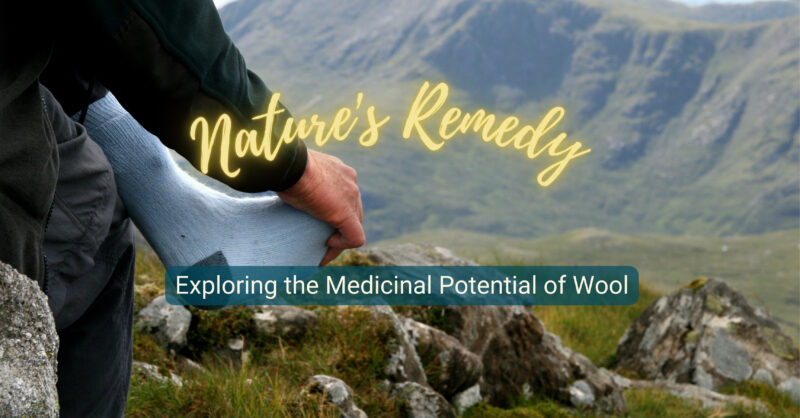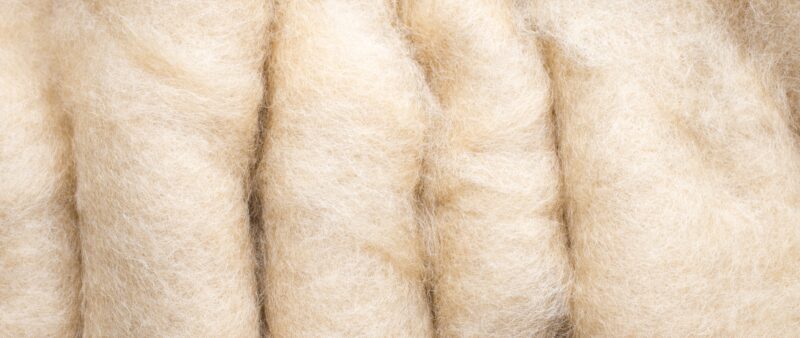
It’s not hyperbole when people speak of wool as a miracle fiber. Back in pre-modern days, if you had some sheep, you had nearly everything you needed for survival—milk, meat, fibers and hides for clothing and bedding, material to trade, and much more. Nothing was wasted, everything had utility and purpose. The revered status of the sheep (and their shepherd) is still felt today in our mythology, astronomy, folk tales, and symbols seen throughout the world.
Synthetic fabrics and other market forces have diminished the importance of sheep’s contributions, but there’s a collective remembering underway. It began with the return of wool as a superior fabric for clothing on multiple levels: comfort, sustainability, performance. And now we’re having fun rediscovering all the ways wool helps us out.
We’ve been inspired recently by a company called WoolAid that’s making Merino wool bandages to replace the plastic ones we’re all familiar with. WoolAid bandages decompose in the soil in only four months, whereas plastic ones…don’t. And of course wool is the perfect fiber for bandages—it’s breathable and moisture wicking, just what wounds need to heal properly.
It reminded us that wool has a legendary reputation for aiding all sorts of ailments. So let’s take a look at both the known and the lesser-known uses of wool for health purposes.
For Wound Care and Blisters
As WoolAid’s bandages suggest, one of the most common uses for wool is preventing and treating sores and blisters. There’s many a story of hiking and backcountry guides recommending wool for blister prevention on long hikes. The cool part about this is that the little wool bundles cushion your hot spot while you walk, but then as the sweaty miles go by, it felts itself into your sock, holding it in place right where you need it.
And there’s an even older story about this very phenomenon. In Christian lore, it is said that as Saint Clement and Saint Christopher were fleeing persecution, they stuffed their sandals with wool to prevent blisters and had wool felt socks by the end of their journey.
Wool can also provide relief from painful corns or where toes rub together, just wrap the batting around those toes. Ballerinas have used wool for centuries to cushion their toes in their pointe shoes. It’s hard to tell by the looks of those dainty ballerinas, but because of its moisture-absorbing properties, wool helps with shoe stench as well. See also: hiking boots, running shoes, work boots, kids’ shoes, and anyone whose feet might need a bit of freshening.
And remember all those sheepskin car seat covers from the 80s? Turns out there was a purpose. Anytime we’re stationary for long periods of time with little movement, pressure can build up on contact points, and bedsores can develop. Sheepskins, also known as wool fleece, have been shown to alleviate and prevent bedsores, so much so that the FDA has approved them for medical use. They can be found in different sizes and shapes for wheelchairs, beds, and seats.
A super promising angle to this being researched right now is the ability of wool to directly help heal wounds. Wool is made up of a protein called keratin, which is also a component of our skin’s outer layer. Initial studies have been conducted on patients with leg ulcers that resist healing. When treated with dressings derived from wool, these difficult ulcers show a remarkable ability to heal faster, likely due to the keratin in the dressings which their own bodies are having trouble producing. This has resulted in an increase of “biofunctional” and “bioactive” materials for wound care.
For Aches and Pains
This is an area where very little research has been done, so we rely on customer testimonials and traditional folk wisdom.
We know, from over 25 years making wool mattresses and bedding, that wool helps people sleep better. For some people with chronic pain or conditions like arthritis and fibromyalgia, our wool mattresses, toppers, and pillows help prevent painful pressure points and cradle their bodies gently, leading to less tossing and turning, and resulting in less lost sleep. And a good night’s rest is absolutely shown to help with better overall health and reduced pain perception.
Some have noticed that applying wool directly to a sore area appears to alleviate pain. We even ran across a small study that looked into the wearing of wool underwear for back pain! According to their results, half of their group of 48 non-specific back pain sufferers experienced a reduction in pain and increase in flexibility. While clearly more research needs to be done for anything conclusive, the use of wool to ease aches and pains is a time-honored remedy.
We often wondered what the wool flannel in the personal care aisle of our grocery store was for, and we discovered that it’s used with grandma’s favorite good ol’ castor oil for a whole list of good reasons, check this out for 30 of them. For external application, the wool flannel is soaked in castor oil then applied to the area, covered with a towel or plastic wrap, and a hot water bottle can be placed on that to help the oil soak in and do its magic. Just be sure to use it correctly, buy oil made without hexane, don’t use if pregnant, and be aware of castor oil’s side effects.
A sleeper hit product for us over the years has been our Medicinal Wool Scarves, a soft, scarf-like strip of our premium wool batting that can be wrapped around your head, neck, or any body part that needs attention. People swear by them! And psst! You can also pull off strips or clumps for the aforementioned blister treatment, and for the next category of health-related wool uses.
For Mama and Baby
The arrival of a newborn is such a special time for both baby and mother, and it comes with its own set of needs. How can wool come to the rescue?
For babies, their diapers create a warm and moist environment that is notorious for causing skin irritation and rashes. For breastfeeding moms, tender nipple skin can really use some soothing. Adding a bit of pure, natural wool to baby’s clean diaper and to mother’s nursing bra can do the trick—just make sure that it’s undyed and cleaned and processed with only the mildest of soaps and no extra chemicals added, just like the wool we use for our bedding.
We’ve got lots more where this came from! Give us a follow on Instagram and Pinterest for more about the magic of wool, and as always—sweet dreams!
THIS ARTICLE DOES NOT PROVIDE MEDICAL ADVICE
The information in this article, including but not limited to text, graphics, images, and other materials, are for informational and educational purposes only. No material here is intended as a substitute for professional medical advice, diagnosis, or treatment. Please consult your physician or other qualified health care practitioner with any questions or concerns you may have for your care.




